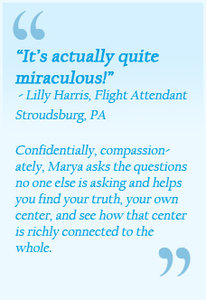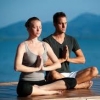LOVE IN THE TIME OF CORONAVIRUS: Social distancing is oddly now prosocial behavior!

Social distancing is prosocial behavior, but it only works in the early stages of this virus.
“Covid-19 is a novel, highly contagious virus that spreads 2-4 times as rapidly as the flu, has a long incubation period of up to 14 days, and can be transmitted by people with mild or perhaps no symptoms. It can survive an average of 4-5 days and perhaps up to 9 on contaminated surfaces as well. All of which make it very, very tough to contain,” writes Stephen Dinan, CEO of the Shift Network.
It’s also more deadly than a regular flu by a long shot, particularly for the elderly and the health-impaired. These are a few of the reasons why we decided to cancel in-person Yoga classes for two weeks (at least) and why I hope you will consider joining the effort to prevent the spread of COVID-19 here on Hawaii Island and around the world. Here are other details to consider:
1 – We don’t have adequate testing to know who may be asymptomatic while already having the virus. These unknowing carriers would not want to infect others.
2 – Social distancing only works in the beginning of a global pandemic. Once the number of infected people reaches 1%, there is no stopping the virus until it has run its full-blown, awful course.
3 – On an island, we are particularly vulnerable. In 1918, a virulent strain of flu managed to spread within a few months to the remotest corners of the world. It infected half a billion people – more than a quarter of the human species – and that was before rapid transport and global commerce amped up the transmission of everything from information to i-phones. It is estimated that the flu killed 5% of the population of India. On the island of Tahiti 14% died. On Samoa 20%. Altogether the pandemic killed tens of millions of people – and perhaps as high as 100 million – in less than a year. More than the First World War killed in four years of brutal fighting. (https://time.com/5803225/yuval-noah-harari-coronavirus-humanity-leadership/)
4 – Yoga is a public health remedy; why flirt with making it a public health danger?
5 – There are other ways for spiritual practice together via Skype, Facetime, Youtube, and Phone. Is it wise to have seaside classes again, which I offered at various times over the last dozen years in Hawaii? What is the best time? These are questions I invite you to play with. Let’s be creative! Taking the precaution of using online and outdoor classes instead of having in-person, indoor classes for two weeks (at least) seems prudent for now. Let’s see where we are in 14 days on Hawaii Island and decide then if we ought to resume then. Better safe than sorry. It can actually be exciting to experiment with these new methods of interacting.
6 – Who isn’t committed to nipping the viral spread in the bud so we can all stay safe? If you must work in a highly social job, you know the protocols – washing hands, sneezing and coughing into your elbow, minimizing touching, cleansing hair, clothes, and surfaces as often as possible. It matters!
7 – What worked to slow the spread of the virus in China was a total shutdown. People stayed home, inside, except with a few exceptions for deliveries and emergencies. When there were no new people in proximity to those already infected, COVID-19 died out and China has perhaps slowed and hopefully begun to stop the unholy terror.
8 – “Many of us were too selfish to follow suggestions to change our behavior,” writes Mattia Ferraresi in the Boston Globe’s A Coronavirus Cautionary Tale from Italy. “Don’t do what we did,” she says. “Now we’re in lockdown and people are needlessly dying.” (https://www.bostonglobe.com/2020/03/13/opinion/coronavirus-cautionary-tale-italy-dont-do-what-we-did/?utm_source=pocket-newtab)
We’re going to be okay- I know this in my heart! I asked the healing spirits, and they say if we do all that we can NOW to FLATTEN THE CURVE. That means we lessen the chance of infection as much as possible now so that hospitals and health professionals won’t be overwhelmed with a sudden rise in infected patients all at once. Then, we can return to normal sooner rather than later.
As of March 11, the WHO announced that COVID-19 is officially a global pandemic. In his announcement, Tedros Adhanom Ghebreyesus, the Director-General of the World Health Organization, stressed, “This is not just a public health crisis, it is a crisis that will touch every sector-so every sector and every individual must be involved in the fight.”
Time is of the essence to contain the virus to prevent it from spreading farther. “We are at a crossroads,” writes Dinan. “We can continue on the path we have been on, in this nation that privileges profit over people and land; or we can unite as citizens with a common cause – the health and wealth of the Earth that sustains us. If we cannot commit to this kind of fundamental shift in our relationship to people and place, then democracy becomes another myth perpetuated by those in power who care only about themselves.” (Read the excellent article Pandemic Preparations Here.
The most responsible thing anyone can do is follow the pubic heath professionals’ advice. Don’t spread misinformation. COVID-19 is fundamentally different from the flu. Yoga twists don’t remove its toxic effects. Sweating out a virus and using essential oils are not a valid means of containment. Strategies and treatments for other viruses currently don’t apply to COVID-19. More than ever, the healing, energy medicine, and yoga communities need to have humility around what we can accurately say about the benefits of our practices.
Dr. Anthony Fauci, Director of the U.S. National Institute of Allergies and Infectious Diseases, has directly contradicted the Trump Administration to dispel the misinformation that COVID-19 can be compared to the flu. The Washington Post reports that “[Fauci] again noted that the novel coronavirus ‘is 10 TIMES MORE LETHAL THAN THE SEASONAL FLU’… He was asked whether the worst was yet to come. He said directly, ‘Yes, yes it is. If we are complacent and don’t do really aggressive containment and mitigation, the number could go way up and be involved in many, many millions.’”
This is an evidence-based recommendation to be taken very seriously. It doesn’t matter if there isn’t coronavirus in your region. You don’t want it to come to your region.
COVID-19 is not the flu. Flu is predictable, with decades of data. COVID-19 is novel-other coronaviruses exist, but this one is only several months old and inherently uncertain. There is no way to accurately predict the natural disease history, which is the term used to refer to the course the disease will take from onset to resolution, according to Yoga International.
Irrespective of health outcomes, one of the most serious threats of COVID-19 is overwhelming health care systems. You might not be able to get treatment for something non-coronavirus related, such as for heart issues, cancer treatment, or injuries.
Public health officials are preparing for a disease burden ten times greater than the flu-“disease burden” meaning the impact of a condition in terms of mortality, morbidity, economics, and other indicators.
“Flattening the curve” is our collective effort to lessen that burden by taking responsible action to care for ourselves and our families.
Public health is yoga in action, addressing health at a personal as well as community level, and it relies on our integrity to take steps to prevent the dangers. While many of us will face serious consequences, it is the most vulnerable we must be concerned for – those who have no health insurance, the elderly, and those with compromised immune systems. Our priority must be to contain the disease.
From Time Magazine: “Epidemics killed millions of people long before the current age of globalization. In the 14th century there were no airplanes and cruise ships, and yet the Black Death spread from East Asia to Western Europe in little more than a decade. It killed between 75 million and 200 million people – more than a quarter of the population of Eurasia. In England, four out of ten people died. The city of Florence lost 50,000 of its 100,000 inhabitants.”
In the centuries since then, in March 1520, a single smallpox carrier – Francisco de Eguía – arrived in Mexico. Central America at that time had no trains, buses or even donkeys. Long distances were very hard to manage, but by December -10 months later — a smallpox epidemic devastated all of Central America, killing up to a third of its population.
In the century that have passed since the virulent 1918 flu pandemic, humankind has become ever more vulnerable to epidemics, due to growing populations and better transport.
I mention these historical experiences not to frighten you, but to awaken all of us to the real results of careless actions. We are here to take care of each other. Taking prosocial precautions through social distancing may seem contradictory to love and Yoga, but removing yourself from these efforts could be called antisocial behavior.
We carry mutual responsibility to get this right. We can save a lot of lives. Or not. It’s up to us.
ADAPTED FROM CLARE KELLEY OF YOGA INTERNATIONAL:
How Students and Teachers Can Practice Public Health Yoga
• Avoid contact, crowds, and unsanitary conditions. Stop going to group classes until further notice.
• If you feel the studio you’re at is too crowded or doesn’t feel properly sanitized, feel empowered to leave.
• If you have the means, consider paying your teacher for the class you would have gone to. Few teachers can afford to lose income.
• Properly clean all surfaces that have been in the yoga studio using an effective cleaner recommended by the CDC or Environmental Working Group.
• Wash your hands. And wash them for 30 seconds-sing the happy birthday song twice (personally, I prefer singing Toto’s Africa)-up to your wrists, and under your fingernails. Any soap is fine. Handwashing is more effective than hand sanitizer.
• Second choice-hand sanitizer. Use enough volume (most people don’t!) and a solution that is at least 60% alcohol. Rub it in for 30 seconds. Allow your hands to dry completely without wiping them off. Avoid products with fragrance. (Make your own with 60% alcohol, 40% aloe vera gel, and three drops of tea tree oil.)
• Moisturize your hands to prevent small cracks or cuts.
• Don’t touch your face. (So hard to avoid, but important!)
• Avoid sharing props, water bottles, food, and so on.
• Face masks are ineffective at preventing you from contracting the virus, and healthcare workers are in dire need of those masks. Unless a healthcare provider has told you to wear them, don’t. If you’re sick enough to want to wear a mask, self-quarantine.
• The containment effort will mean a global binge of disposable products. Look for ways that you can reduce your own use of plastics, fast fashion, and other wasteful consumer items to offset the burden to our more-than-human family.
If you have comments, questions, or need support, please reach out to me through the contact form below.


